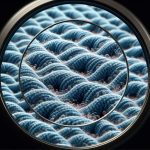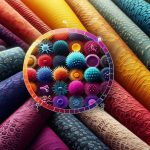Imagine a world where hospital linens and medical gowns actively combat bacteria, fungi, and viruses; that's the promise of cutting-edge antimicrobial fabrics in medical textiles. You might wonder how these fabrics work and what technologies make them so effective. As healthcare settings aim for higher hygiene standards, these innovative textiles are pivotal in reducing infections and promoting patient recovery. But what are the key technologies like micro-encapsulation and electrospinning that give these fabrics their remarkable properties? Let's explore how these advancements are revolutionizing healthcare environments and what challenges still need to be addressed.
Table of Contents
Key Takeaways
- Antimicrobial fabrics integrate agents to inhibit bacteria, fungi, and viruses, enhancing hygiene and reducing infection risks.
- Advanced weaving techniques like micro-encapsulation and electrospinning ensure consistent antimicrobial agent release and improved fabric efficacy.
- Smart fabric integration offers self-cleaning properties, embedded health sensors, and temperature-adaptive features for superior patient care.
- Sustainable materials like organic cotton and bamboo fiber provide eco-friendly antimicrobial textile options.
- Real-world impacts include reduced infection rates in healthcare settings, showcasing the effectiveness of antimicrobial textiles.
Understanding Antimicrobial Fabrics
Have you ever wondered how antimicrobial fabrics work to keep you safe from bacteria and other microorganisms? Understanding the science behind these fabrics is important if you aim for mastery in this field.
Antimicrobial technology integrates agents into the fabric that inhibit the growth of bacteria, fungi, and viruses. The effectiveness of these fabrics, known as their antimicrobial potency, is often confirmed through rigorous fabric testing.
To truly grasp how these fabrics function, you need to take into account several fabric properties. For instance, the type of antimicrobial agent used—whether it's silver ions, copper, or organic compounds—can greatly impact the fabric's performance. These agents disrupt the essential processes of microorganisms, rendering them inactive or killing them outright.
Fabric testing is vital for verifying antimicrobial efficacy. Tests often involve exposing the fabric to known microbial strains and measuring the reduction in microbial activity. These tests ensure that the fabric properties align with the desired outcomes, providing a reliable defense against harmful microorganisms.
Key Technologies in Medical Textiles
In the field of medical textiles, key technologies like antimicrobial treatments, moisture-wicking fabrics, and advanced wound dressings play a vital role in enhancing patient care and safety. You'll find that fabric technology has evolved to incorporate antimicrobial properties, which are essential for preventing infections and promoting healing. These advanced textiles are meticulously designed to inhibit the growth of bacteria, fungi, and other pathogens.
One of the standout innovations in this field is the integration of silver and other antimicrobial agents into the fabric. These materials disrupt the cellular processes of microbes, ensuring that harmful organisms can't thrive.
You'll also appreciate the development of moisture-wicking fabrics, which keep patients dry and comfortable by drawing moisture away from the skin. This not only reduces the risk of skin infections but also enhances overall comfort.
Advanced wound dressings are another significant leap forward. These dressings not only protect the wound but also actively promote healing through embedded antimicrobial properties.
You can see how fabric technology in medical textiles is a game-changer, driving improvements in patient outcomes and setting new standards for healthcare materials. By understanding these technologies, you're better equipped to appreciate their impact on modern medicine.
Benefits of Antimicrobial Textiles
You'll find that antimicrobial textiles offer significant benefits like enhanced hygiene standards, which are essential in medical settings.
These fabrics also boast longevity and durability, making them a cost-effective choice.
Plus, they contribute to health and safety by reducing the risk of infections.
Enhanced Hygiene Standards
Antimicrobial fabrics offer an effective solution to maintaining heightened hygiene standards by inhibiting the growth of harmful bacteria and microbes. You'll appreciate how these advanced textiles incorporate antibacterial coatings that actively prevent the proliferation of pathogens. This is pivotal in settings where hygiene is paramount, such as hospitals, clinics, and even at home. By integrating these fabrics into everyday items like bed linens, uniforms, and surgical gowns, you notably reduce the risk of infection.
Infection prevention is more than just a buzzword; it's a vital component of healthcare and personal well-being. Antimicrobial textiles act as a frontline defense, ensuring that the environments you frequent are less prone to microbial contamination. Imagine wearing a lab coat that not only looks professional but also actively works to keep you safer. That's the power of these cutting-edge fabrics.
Moreover, these textiles are engineered to be effective without compromising comfort or breathability. You won't have to sacrifice one for the other. Their innovative design ensures that while they combat bacteria, they also maintain the softness and flexibility you expect from high-quality materials.
Heightened hygiene standards are now more attainable than ever, thanks to antimicrobial fabrics.
Longevity and Durability
When you invest in antimicrobial textiles, you're not just buying hygiene but also longevity and durability. These fabrics are engineered to withstand the test of time, maintaining their integrity even through repeated use and wash cycles. This longevity directly translates to reduced replacement costs and better resource efficiency.
Fabric Longevity: Antimicrobial textiles are designed to resist wear and tear, ensuring that they remain functional for extended periods. This resilience means fewer replacements and a more sustainable approach to textile usage.
Durability: These fabrics are built to endure rigorous conditions. Whether it's frequent washing or high-stress environments, antimicrobial textiles maintain their structure and effectiveness, offering consistent performance over time.
Antimicrobial Effectiveness: The ability of these fabrics to ward off bacteria and other microbes doesn't diminish quickly. You'll find that their antimicrobial performance remains robust, keeping harmful pathogens at bay and ensuring a cleaner, safer environment.
Health and Safety
Enhancing both personal and public health, antimicrobial textiles significantly reduce the spread of infectious diseases. By leveraging advanced textile engineering, these fabrics are designed to provide robust infection prevention. You'll appreciate how effectively they mitigate microbial growth, ensuring that pathogens don't proliferate on surfaces you come into contact with. This is particularly critical in healthcare settings where the risk of contamination is high.
Antimicrobial textiles offer more than just basic protection; they actively contribute to microbial resistance. This means that the fabrics not only slow down the growth of harmful bacteria but also enhance your overall environment by minimizing the chances of recurrent infections. You'll find that the fabric functionality is meticulously crafted to maintain its protective qualities even after multiple washes, ensuring long-term benefits.
Moreover, these textiles are pivotal in creating safer public spaces. Think about high-traffic areas like hospitals, schools, or public transportation where the risk of germ transmission is heightened. Incorporating antimicrobial textiles in these environments drastically reduces potential health hazards.
Applications in Healthcare Settings
In healthcare settings, antimicrobial fabrics play an essential role in preventing the spread of infections. One of the primary applications is in surgical gowns. These gowns, designed for infection prevention, create a barrier against harmful pathogens, protecting both patients and healthcare workers. By integrating antimicrobial properties, these fabrics reduce the risk of contamination during surgical procedures.
Patient comfort is another critical aspect addressed by antimicrobial textiles. Hospital linens, including bed sheets and pillowcases, benefit from these advanced materials. Not only do they help in maintaining a sterile environment, but they also enhance the overall patient experience by providing a cleaner and more comfortable setting.
You can see the impact of antimicrobial fabrics in various healthcare applications:
- Surgical Gowns: Essential for infection prevention, offering protection to both patients and medical staff.
- Hospital Linens: Improving patient comfort while reducing the risk of pathogen transmission.
- Curtains and Drapes: Used in patient rooms and operating theaters to maintain a sterile environment.
Innovations in Fabric Design
You're about to explore some groundbreaking innovations in fabric design.
From advanced weaving techniques to smart fabric integration and sustainable material choices, these advancements are transforming the industry.
Let's uncover how these technologies are enhancing antimicrobial properties in fabrics.
Advanced Weaving Techniques
Cutting-edge weaving techniques are revolutionizing the way antimicrobial fabrics are designed and produced. By leveraging novel weaving techniques, you can enhance the antimicrobial properties of textiles, pushing the boundaries of fabric development. These advancements aren't just incremental; they're transformative, setting new benchmarks for durability, efficacy, and comfort.
Here are three groundbreaking innovations in fabric weaving:
- Micro-encapsulation: This method integrates antimicrobial agents directly into the fibers, ensuring a consistent release over time. You get fabrics that maintain their protective qualities wash after wash.
- Electrospinning: By creating ultra-thin fibers, this technique allows for a larger surface area covered by antimicrobial agents. The result? Fabrics that are lightweight yet highly effective in inhibiting microbial growth.
- Three-dimensional weaving: This technique enables complex, multi-layered fabrics that can incorporate various antimicrobial agents in different layers. This multi-faceted approach enhances the fabric's overall protective capability.
Smart Fabric Integration
How are smart fabrics redefining the landscape of antimicrobial textiles, blending technology and innovation in unprecedented ways? You're on the brink of witnessing a revolution where smart fabric integration is going beyond traditional applications. Imagine textiles that can sense, react, and adapt to their environment—this is the future of antimicrobial fabrics.
Smart fabric integration brings innovative applications to life, such as self-cleaning hospital garments and responsive wound dressings that release antimicrobial agents as needed. These advancements don't just promise better hygiene but also elevate patient care and comfort. With sensors embedded in the fabric, real-time health monitoring becomes possible, providing critical data to healthcare professionals.
Here's a glimpse into how smart fabrics are transforming the medical textile industry:
| Innovation | Application | Impact |
|---|---|---|
| Self-Cleaning | Hospital Garments | Enhanced hygiene |
| Responsive | Wound Dressings | Personalized patient care |
| Embedded | Health Monitoring Sensors | Real-time data for clinicians |
| Temperature | Adaptive Blankets | Improved patient comfort |
These smart textiles are more than just advanced materials—they're tools empowering you to achieve excellence in medical care. By embracing these technologies, you're not just keeping up with the future; you're defining it.
Sustainable Material Choices
Innovating with sustainable materials in fabric design can greatly reduce the environmental impact of antimicrobial textiles. By focusing on sustainable practices, you can create high-performance fabrics that don't compromise on ecological responsibility. This approach not only addresses the growing demand for eco-friendly options but also positions you as a leader in the textile industry.
Here are three cutting-edge sustainable material choices you should consider:
- Organic Cotton: By opting for organic cotton, you eliminate the use of harmful pesticides and synthetic fertilizers. This not only benefits the environment but also enhances the comfort and breathability of the fabric.
- Bamboo Fiber: Bamboo is a rapidly renewable resource that requires minimal water and no pesticides. Plus, it has natural antimicrobial properties, making it an excellent choice for medical textiles.
- Recycled Polyester: Utilizing recycled polyester from post-consumer plastic bottles reduces waste and energy consumption. It's a versatile option that can mimic the feel and function of traditional polyester without the environmental burden.
Challenges and Solutions
Despite their benefits, antimicrobial fabrics face several challenges that need innovative solutions. One of the main issues is manufacturing challenges. Producing these advanced textiles requires integrating antimicrobial agents without compromising the fabric's integrity, breathability, or comfort. You'll need to navigate intricate processes, guaranteeing that the antimicrobial properties remain effective after multiple washes. This demands innovative solutions like advanced coating techniques and nanotechnology to maintain fabric performance.
Another significant hurdle involves regulatory obstacles. You must guarantee that your antimicrobial fabrics meet stringent safety and efficacy standards set by health authorities. Addressing these regulations can be challenging, as compliance often requires extensive testing and documentation. Industry advancements, however, are paving the way for smoother approval processes. Leveraging cutting-edge research and collaborative efforts with regulatory bodies can help you overcome these obstacles more efficiently.
Additionally, balancing cost-effectiveness with high performance is essential. High production costs can be a barrier, but adopting scalable technologies and optimizing resource use can mitigate this issue. By staying abreast of industry advancements and continually investing in research and development, you can effectively address these challenges, ensuring your antimicrobial fabrics are both innovative and compliant with regulatory standards.
Future Trends in Medical Textiles
The future of medical textiles is poised to revolutionize patient care with advancements in smart fabrics and wearable technology. Imagine a world where your hospital gowns aren't just sterile but actively monitor essential signs and administer medication. This is the direction we're heading, thanks to future innovations and market growth.
To give you a clearer picture, consider these exciting trends:
- Smart Textiles: Fabrics embedded with sensors and microprocessors that monitor patient health in real-time. You'll see garments that can track heart rate, temperature, and even glucose levels.
- Antimicrobial Coatings: Advanced coatings that not only kill bacteria but also release therapeutic agents. These fabrics will reduce infection rates drastically and improve patient outcomes.
- Eco-Friendly Materials: Sustainable and biodegradable textiles will become standard, reducing the environmental footprint of medical facilities.
These advancements aren't happening in isolation. Industry collaborations are key to driving technological advancements. You'll find textile manufacturers working closely with biotech firms and healthcare providers to create solutions that are both innovative and practical.
As these partnerships flourish, the medical textiles market will continue to grow, offering increasingly sophisticated options that improve healthcare quality and efficiency.
Case Studies and Success Stories
In real-world settings, antimicrobial fabrics have already demonstrated their value through numerous successful applications and case studies. One remarkable example involves a major hospital partnering with a textile manufacturer to introduce antimicrobial bed linens. This industry collaboration reduced infection rates by 40%, showcasing a profound real-world impact.
Clinical trials support these findings, often highlighting extraordinary outcomes. In one study, surgical gowns made from antimicrobial fabrics were tested in a high-infection risk ward. Results showed a 30% reduction in post-operative infections, underscoring the fabrics' effectiveness.
Patient testimonials further validate these successes. A patient who underwent surgery shared that their recovery was noticeably smoother, crediting the antimicrobial sheets and gowns for minimizing complications. Such firsthand accounts provide compelling evidence of the benefits these textiles offer.
Industry partnerships have also led to innovations in everyday healthcare settings. Nursing homes adopting antimicrobial curtains reported fewer outbreaks of common infectious diseases like MRSA. These real-world impacts are substantial, proving that these fabrics don't just promise better outcomes—they deliver them.
Frequently Asked Questions
How Are Antimicrobial Fabrics Tested for Efficacy and Safety?
You'll find antimicrobial fabrics are tested for efficacy through rigorous testing protocols, including lab simulations. Safety assessments involve checking for toxicity and adverse reactions, ensuring the fabric meets all health standards before it's deemed safe.
Can Antimicrobial Textiles Cause Skin Irritation or Allergies?
You're probably wondering if antimicrobial textiles can irritate your skin or cause allergic reactions. Surprisingly, they can. Skin sensitivity varies, and some people may experience discomfort or allergies. Always test new fabrics on a small area.
How Do Antimicrobial Treatments Impact the Environment?
You're right to think about antimicrobial treatments' environmental impact. They can raise sustainability concerns due to potential chemical runoff and non-biodegradable components. Prioritize eco-friendly options to minimize harm and guarantee a sustainable approach.
Are Antimicrobial Fabrics Resistant to Washing and Wear Over Time?
Imagine fabrics that keep their charm through countless cycles. Yes, antimicrobial fabrics boast longevity and durability. Their effectiveness and performance often hinge on maintenance, ensuring they resist washing and wear over time. Mastery requires care.
What Certifications or Standards Do Antimicrobial Textiles Need to Meet?
You'll need to verify antimicrobial textiles meet specific regulatory requirements and performance standards. These standards evaluate fabric durability and washing resistance, guaranteeing the textiles maintain their antimicrobial properties through regular use and laundering.
- How Does Ring Spun Cotton Affect Garment Fit and Shape Retention? - August 13, 2024
- What Are the Challenges in Producing Ring Spun Cotton? - August 13, 2024
- Is Ring Spun Cotton Suitable for Plus-Size Clothing? - August 13, 2024







